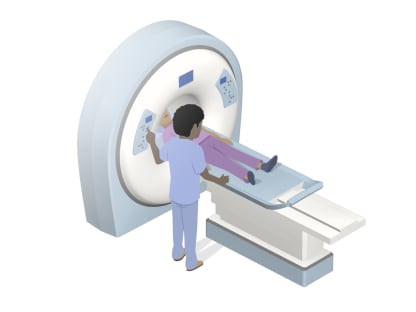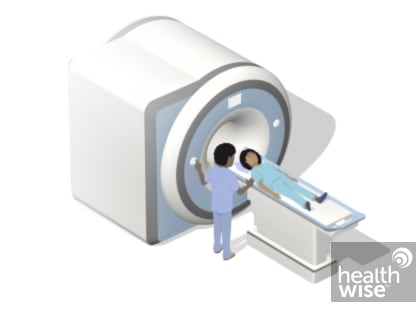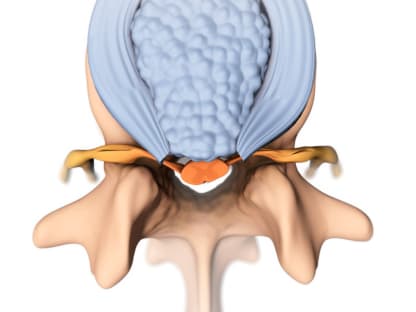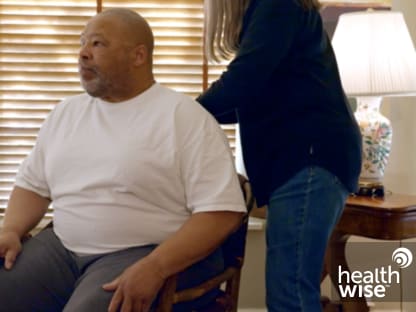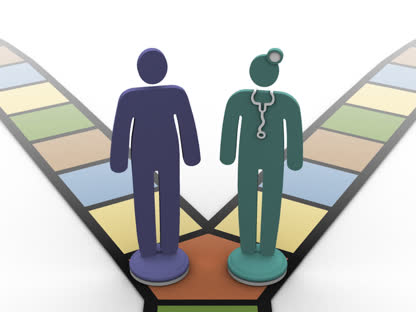Lumbar Spinal Stenosis
Make an Appointment
Our team is here to help you make an appointment with the specialists that you need.
Lumbar Spinal Stenosis
Condition Basics
What is lumbar spinal stenosis?
Lumbar spinal stenosis is a narrowing of the spinal canal in the lower back, known as the lumbar area.
The spine is made up of bones called vertebrae. The spinal cord runs through an opening in the bones called the spinal canal. Sometimes bones and tissue grow into this canal and press on the spinal cord and/or the nerves that branch out from it. This causes pain, numbness, or weakness in the back, buttocks, legs, and feet.
What causes it?
The most common cause of lumbar spinal stenosis is changes in the spine that can happen as you get older. These changes include thickening of soft tissues, development of bony spurs, and the slow breakdown of spinal discs and joints over time. Any of these conditions can narrow the spinal canal.
What are the symptoms?
The most common symptom of lumbar spinal stenosis is leg pain that happens when you walk or stand but feels better when you sit. Other symptoms may include numbness, weakness, and cramping in the back, legs, feet, or buttocks. Many people don't have any symptoms.
How is it diagnosed?
The doctor can usually diagnose lumbar spinal stenosis by asking about the history of your symptoms, doing a physical exam, and using imaging tests. The tests may include an MRI, CT scan, and X-rays. The tests can help your doctor be sure you have stenosis or can rule out other problems.
How is lumbar spinal stenosis treated?
Treatment for lumbar spinal stenosis includes taking medicine for pain and getting physical therapy. Exercise and changing the way you do your activities may also help. Steroid injections to reduce inflammation in the nerve root are sometimes tried. If you still have symptoms after the treatments, surgery may be considered.
Health Tools
Health Tools help you make wise health decisions or take action to improve your health.
Cause
The most common cause of lumbar spinal stenosis is changes in the spine that can happen as you get older.
These changes include thickening of soft tissues, development of bony spurs, and the slow breakdown of spinal discs and joints over time. Any of these can narrow the spinal canal.
These age-related changes often happen when you have certain disorders. For example:
- Arthritis of the spine wears away joint cartilage and causes bony growths (spurs).
- Certain bone diseases, such as Paget's disease and ankylosing spondylitis, may soften the spinal bones or cause too much bone to grow.
Other causes include:
- An abnormally narrow spinal canal. This can be a genetic condition.
- Spondylolysis. A vertebra may slide forward or backward over the bone below and may squeeze the spinal cord.
- Spinal fracture.
- Cancer.
- Fibrosis. This is excess, ropy tissue much like scar tissue. It can come from having had spine surgery.
Symptoms
The most common symptom of lumbar spinal stenosis is leg pain that happens when you walk or stand but feels better when you sit. You feel pain in your legs because the nerve roots that pass through the lower spine extend to the legs. Symptoms occur when these nerve roots get squeezed.
Other symptoms may include:
- Numbness, weakness, and cramping in the legs, feet, or buttocks.
- Stiffness in the legs and thighs.
- Low back pain.
- In severe cases, loss of bladder and bowel control.
Many people, especially those older than age 50, have some narrowing of the spinal canal but don't have symptoms. If there are symptoms, they may be very bad at times and not so bad at other times.
What Happens
Narrowing of the spinal canal can squeeze and irritate the nerve roots that branch out from the spinal cord. This is what causes pain and other symptoms. It usually starts gradually and gets worse over time. Symptoms may stay the same, get better, or get worse. Most often, it doesn't cause disabilities.
When to Call a Doctor
Call 911 or other emergency services immediately if a person has signs of damage to the spine after an injury (such as a car crash, fall, or direct blow to the spine). Signs may include severe back pain, or weakness, tingling, or numbness in one or both legs.
Call your doctor now if:
- You have a new loss of bowel or bladder control.
- You have leg pain along with persistent weakness, tingling, or numbness in any part of the leg from the buttock to the ankle or foot.
- You have low back pain along with vomiting, fever, or both.
- Leg pain, weakness, numbness that comes and goes (intermittent), or tingling lasts longer than 1 week even though you use home treatment.
- Significant back pain either does not improve or gets worse over 2 weeks.
Watchful waiting
Lumbar spinal stenosis usually gets worse gradually over months to years. If you have symptoms that come on suddenly, you may have another serious condition and should call your doctor.
If you start to regularly have leg pain when walking and standing, call your doctor.
Exams and Tests
The doctor can usually diagnose lumbar spinal stenosis by:
- Asking about your history of symptoms.
- Doing a physical exam.
- Using imaging tests. These take different kinds of pictures of your body. Tests may include:
- MRI, to check your spinal nerves and look for disc problems.
- CT scan, to check your bones and joints.
- X-rays, to check for arthritis or injuries to the bones of the spine (vertebrae).
- Bone scan, to rule out cancer and other bone diseases.
- Electromyogram and nerve conduction tests, to see if other problems may be causing or adding to your symptoms.
Your doctor may try nonsurgical treatment, such as pain-relieving medicines, exercise, and physical therapy, for a period of time before ordering imaging tests. If treatment works, you may not need tests.
Learn more
Watch
Treatment Overview
Treatments for lumbar spinal stenosis include:
- Medicines to help manage pain.
- Medicines include NSAIDs and acetaminophen.
- Physical therapy.
- This includes stretching and strength exercises that may reduce pain and other symptoms.
- Steroid shots (injections).
- If other nonsurgical treatments haven't worked, these shots are sometimes tried to help leg pain by reducing inflammation in the nerve root. They may work for some people. But they may work for only a short time.
- Surgery to relieve pressure on the nerve roots.
- Unless the symptoms are disabling, most people with lumbar spinal stenosis don't need surgery. Surgery is most often used to relieve pain, numbness, or weakness in the legs.
- Interspinous process devices.
- These small devices can be put between the bones of the spine to take pressure off the nerve roots. This may be an option for some people.
Exercise and changing the way you do your activities may also help you feel better.
Learn more
Watch
Self-Care
You can take steps to treat lumbar spinal stenosis symptoms at home. Be sure to talk with your doctor before you start home treatment.
Steps you can try include:
- Changing the way you do your activities.
- This means trying other ways of doing your activities—ways that don't cause pain or make other symptoms worse. For example, this might mean using a tall stool for tasks that you would normally do standing up. Or you could use a shopping cart or a wheeled walker so that you're leaning forward a little when you walk.
- Taking medicines to manage pain.
- Medicines include nonsteroidal anti-inflammatory drugs (NSAIDs) and acetaminophen. NSAIDs, such as ibuprofen and naproxen, seem to be the best over-the-counter pain medicines. But if you can't take NSAIDs, you can try acetaminophen. Be safe with medicines. Read and follow all instructions on the label.
- Exercising.
- You can try walking on a treadmill with a slight incline. Or you could ride a stationary bike. In both of these types of exercise, your spine tilts forward a little as you work out. So they might be more comfortable for you than other exercises. Your doctor or physical therapist may also teach you exercises to improve strength and flexibility.
- Limiting activities that make your symptoms worse.
- Depending on the severity and location of your stenosis, these activities might include walking (especially walking downhill) and standing for a length of time.
- Taking steps to lower your risk of falling.
- These steps include trying to remove household hazards, such as throw rugs, and clearing cluttered walkways.
Learn more
Watch
Credits
Current as of: July 31, 2024
Author: Ignite Healthwise, LLC Staff
Clinical Review Board
All Healthwise education is reviewed by a team that includes physicians, nurses, advanced practitioners, registered dieticians, and other healthcare professionals.
Current as of: July 31, 2024
Author: Ignite Healthwise, LLC Staff
Clinical Review Board
All Healthwise education is reviewed by a team that includes physicians, nurses, advanced practitioners, registered dieticians, and other healthcare professionals.
 Spinal Stenosis: Lumbar
Spinal Stenosis: Lumbar Spinal canal
Spinal canal Spinal cord anatomy
Spinal cord anatomy Discs of the Spine
Discs of the Spine Cartilage
Cartilage Back Surgery for Spinal Stenosis: Before Your Surgery
Back Surgery for Spinal Stenosis: Before Your Surgery Back Surgery for Spinal Stenosis: Returning Home
Back Surgery for Spinal Stenosis: Returning Home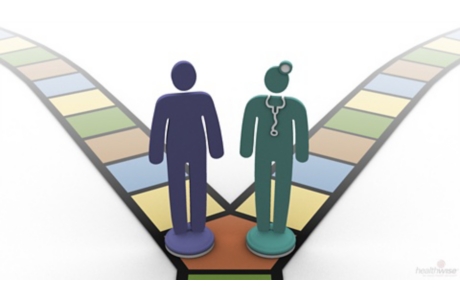 Deciding About Spinal Stenosis Surgery
Deciding About Spinal Stenosis Surgery Lumbar spinal stenosis: Fast Facts
Lumbar spinal stenosis: Fast Facts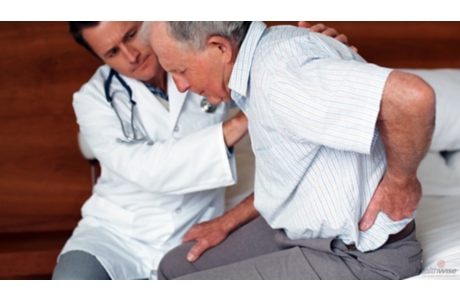 Spinal Stenosis Surgery: How Others Decided
Spinal Stenosis Surgery: How Others Decided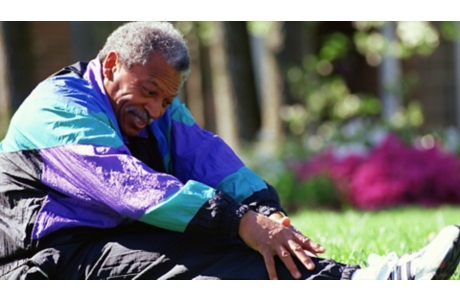 Spinal Stenosis: Home Treatment and Physical Therapy
Spinal Stenosis: Home Treatment and Physical Therapy
This information does not replace the advice of a doctor. Ignite Healthwise, LLC, disclaims any warranty or liability for your use of this information. Your use of this information means that you agree to the Terms of Use. Learn how we develop our content.
To learn more about Ignite Healthwise, LLC, visit webmdignite.com.
© 2024-2025 Ignite Healthwise, LLC.
This information does not replace the advice of a doctor. Ignite Healthwise, LLC, disclaims any warranty or liability for your use of this information. Your use of this information means that you agree to the Terms of Use. Learn how we develop our content.
